|
|
1. Introduction
Last modified: 02.02.2015
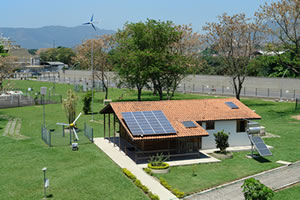
Floor plan
The Efficient Solar House, located in the premises of the Fundão Island's Electric Power Research Center (CEPEL), Rio de Janeiro, is part of the residential segment of the Center for the Application of Efficient Technologies (CATE) of CEPEL and Reference Center for Solar and Wind Energy Sérgio de Salvo Brito (CRESESB) in its strategy for creating Demonstration Centers. Its construction, in addition to CEPEL, counted with the participation of several institutions such as the Department of Mines and Energy (MME) and ELETROBRÁS. The Solar House is a prefabricated house with all efficient electrical and electronic equipment from the point of view of conservation of energy powered by solar panels and a wind turbine, and water heating also based on solar energy. One of the main goals of the Efficient Solar House is to serve as a multiplier for the use of solar thermal, solar PV and wind energy, as well as techniques to prevent energy wastage. The House consists of a mini auditorium for thirty people; a "control room" where there is the house's energy control system (charge controllers and inverter) and data acquisition system; an "energy efficiency room" where there is a panel lighting demonstration, a meter panel, CEPEL digital meter, ampere-hour meter, consumption simulation model and consumption measurement counter for appliances; a bathroom with water heated by thermo pane; a kitchen with efficient appliances. Outside the house there is also a photovoltaic water pumping system, a battery bank and two wind turbines, one feeds the house with electricity, installed 12 meter high, and another at ground level for demonstration purposes only. The Solar House is also an object of research of the integrated functioning of these technologies. Operating since July 1997, the Efficient Solar House received until the end of 2014 almost 18,000 visitors, including teachers and high school students and university professionals and the general public. In addition to the technical visits, the Solar House has attracted the attention of the mass media in the country (television, radio, newspapers and magazines), and became the object of articles in the main Brazilian media, helping promote alternative energy and energy efficiency for a diverse audience of millions of people. 1.1. Floor plan
2. Photovoltaic Generation System
Last modified: 27.01.2015
The Efficient Solar House (CSE) is a prefabricated house with its electricity needs fully fulfilled by solar and wind energy sources. The house's power generation system (SGEE) consists of two arrays of polycrystalline silicon (p-Si) photovoltaic modules, being one fixed and one movable with solar tracking system, adding an output of about 1990 watts peak (Wp) and a wind turbine of 1 kW, as shown in Figure 1.  Figure 1 - Configuration of the electrical generation system of the solar house The electrical system of the Solar House has the following general characteristics: - Photovoltaic array: 1993 Wp
- Battery Bank: 750Ah/48Vcc (20 units)
- Inverter: 48Vcc/120Vca/60Hz-4kW
- Autonomy: 72 hours
- Projected consumption: 7.4 kWh/day
- Annual average rad.: 4.75 to 5.25 kWh / m2.day (Source: INPE, 2006. Atlas Brasileiro de Energia Solar)
2.1. Fixed panel 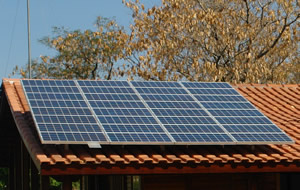
Figure 2 - Fixed Photovoltaic Panel on the roof of the Solar House.
The fixed photovoltaic panel installed on the roof of the porch is composed of a total of 32 PV modules (Figure 2). The modules are grouped into connections in a series of four modules each, achieving a voltage of 48 volts DC (direct current). The eight series-groups of four modules are then connected in parallel, as illustrated in Figure 3. The fixed photovoltaic panel has total power of 1450 Wpeak. 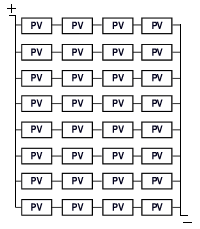 Figure 3 - Connection of the modules of fixed photovoltaic panel. The fixed panel is oriented to the north with an inclination of 22.5° (corresponding to the latitude of the city of Rio de Janeiro). 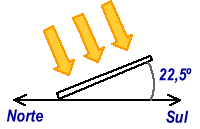 Figure 4 - Angle of inclination of the photovoltaic panels 2.2. Tracking Panel 
Figure 5 - Panel with photovoltaic solar tracking system.
The photovoltaic tracking panel mounted in front of the Solar House has a structure that follows the movement of the sun throughout the day (east - west). It consists of 12 photovoltaic modules connected in groups-series of four modules each (48 Volts DC in each group) associated in parallel. The photovoltaic tracking panel has a total power of 540Wp (Figure 6). The solar tracking structure is a passive system that works based on the movement of a gas between two hollow arms located on opposite sides of the structure.  Figure 6 - Connection of the modules of the PV tracking panel. Depending on the sun position, one of the arms will be warmer than the other, causing expansion of gas that will move to the less heated arm. The displacement of the gas causes unbalance of weight of the structure, causing it to incline to the side of the heavier arm (the arm less heated by the sun). With the movement of the sun this unbalancing process will occur by gradual displacement of the gas causing the entire structure to follow the sun movement. The motion of the structure is such that the incidence of the sun is always perpendicular to the panel plane, favoring the use of solar energy. The gain of solar radiation of such mobile solar tracking structure is approximately 15-20% compared with the fixed assembly of PV modules. The voltage generated by the photovoltaic system is 48 volts, direct current (DC). Since all equipment used in the Solar House works in alternating current (AC), we use a voltage inverter that will convert DC to AC. 2.3. Photovoltaic Cells The materials most commonly used in the manufacture of photovoltaic cells are: (a) monocrystalline silicon (mono-Si), (b) polycrystalline silicon (poly-Si) and (c) amorphous silicon (a-Si) (Figure 7). The highest efficiency in converting solar energy into electricity is obtained with monocrystalline silicon cells (around 18%), which are unfortunately the most expensive.The polycrystalline silicon cells present yield by 16% and are cheaper than the previous due to the lower energy required for its manufacture and best use of material.The amorphous silicon cells are cheaper but its yield is still low (around 10%).Photovoltaic cells are connected in series-parallel sets composing photovoltaic modules with different power and voltages. 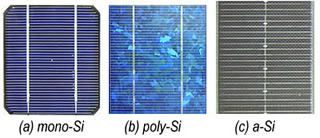 Figure 7 - Types of commercial photovoltaic cells. The PV modules are still expensive, making the energy obtained through them, for now, more expensive than that obtained by hydraulic or even thermal sources. However, for regions far from major centers of generation and consumption it is an economical option. For small communities in rural Brazil, for example, it is a viable technical and economical solution. CEPEL, working with the support of PRODEEM, has installed hundreds of systems in this kind of communities with excellent results. The cost tendency of modules is to decrease, both because of improvements in the manufacturing technology and because of economies of scale by gradual increase of its use.
3. Wind Generation System
Last modified: 27.01.2015
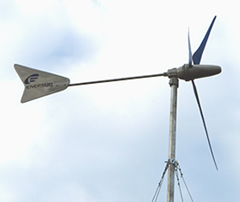
Wind turbine 1 kW, AC, 3ø
The Efficient Solar House has a small wind turbine with a nominal power of 1000 W, alternating current (AC), three phases (3Ø). This machine, installed at 12 meters high, was added in October 2006 to the Solar House's generation system in parallel with the photovoltaic generation system. The turbine consists of a rotor comprising the blades and the hub, driven by the wind that drives an asynchronous generator, generating AC electricity. The output voltage of the wind turbine is then converted from AC into direct current (DC) through an electronic converter called a rectifier, and it feeds the battery bank with the operating voltage of 48 volts DC. The power in AC of Solar House's equipment (like those found in a conventional house) is made from the load controller, but before that the output voltage is converted from DC to AC by a voltage source inverter. 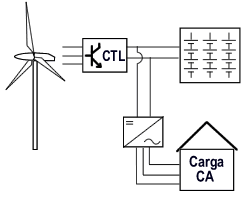 Figure 5 - Wind generation system topology.
4. Battery Bank
Last modified: 27.01.2015
The battery bank is the system of energy storage used in the Solar House to provide power at night or on rainy days, when the generation of photovoltaic panels is null or insufficient (low levels of solar irradiance, that is, incident solar radiation). It has been designed to meet, considering the initially charged batteries, a daily consumption of 7.4 kWh for three consecutive days without energy supply from photovoltaic panels or the wind turbine. This corresponds to a storage capacity of useful energy of about 22.3 kWh (Figure 1). 
Figure 1 - Battery bank.
The battery bank consists of 20 sealed stationary lead-acid batteries of 150 Ah/12 Volts C20 (with deep discharge cycle) connected on 5 arrays of 4 batteries linked in series connected in parallel, operating at a voltage of 48 Volts CC. The assembly was done with cross-wiring in order to equalize the levels of voltage and current to which the batteries of the bank are submitted (Figure 2). 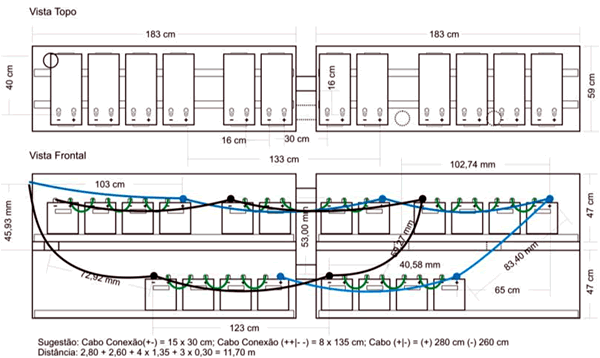
Figure 2 - Connection of the battery bank.

Figure 3 - Electrical box containing the DC bus, the load controller and transducers for measuring current and voltage connected to the data acquisition system of the Solar House.
The energy generated by the photovoltaic panels goes to the load control system, consisting of drivers loading and unloading. The purpose of load control system is to manage the flow of energy: it stores energy surplus or requests stored energy in the batteries if the power generated by the panels at a given moment is not enough to meet consumption. The charge controller must disconnect the power source when the batteries reach full charge. This action prevents the batteries from being overcharged and prevents thereby the generation of gas from the electrolysis of water and their overheating, reducing water loss and preserving battery life. The discharge controller requires at regular intervals energy from batteries so that its life is not compromised by long periods of inactivity, even if the power generation is sufficient to meet consumption. Because batteries are always static, if they were not requested by its controller, its electrolyte fluid decantation could cause the acceleration of chemical wear of the plates of the battery. The discharge controller also prevents voltage in batteries to drop below a certain minimum level of security, to preserve their life, when for some reason (excessive consumption or lack of sunshine) the batteries are not replaced by isolated system generation. Most load controllers are used in solid microprocessed state with load switching relay. 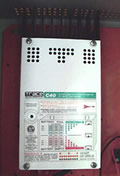
Figure 4 - Detail of battery load Controller used in the Solar House.
The Solar House uses a separate load controller (Figure 4) and a discharge controller integrated with the voltage inverter used.
5. Solar Water Heating System
Last modified: 27.01.2015
The Solar House has a solar water heater on the roof for the bathroom shower and kitchen tap, and a system of external solar heating for demonstration (Figure 1). The external installation of these systems is not very common but it is an alternative for situations where local conditions are not suitable. 
Figure 1 - External solar heating system
Solar thermal energy, i.e., using the sun's energy to heat water is becoming increasingly frequent. The solar heating system is basically composed by a flat solar collector and a heat reservoir. The solar collector is responsible for absorption of solar radiation and for transferring the work fluid (usually water) in the form of thermal energy. The flat solar collectors, used for water heating, can be classified into two groups: closed and open. Closed collectors are used to promote water heating to temperatures up to 70 oC; open collectors are recommended for heating pools that operate at low temperature, between 28 and 30 0C. The flat solar collector consists of a metal housing made of aluminium which has therein an absorber plate painted black and copper tubes, through which the water to be heated flows. In front of the collector there is a transparent glass cover. The whole system is thermally insulated to prevent heat loss to the environment. The system has a good seal to keep it free from external moisture. Figure 2 illustrates the operating principle of the solar water heating system in the area, where the area in red represents warmer water that has been heated by solar radiation in the plane collector in comparison to the area in blue. 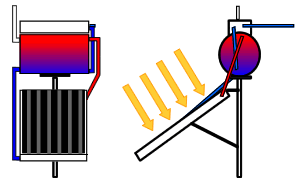 Figure 2 - Operation of the solar heating system. The heat reservoir is a tank for storing hot water coming from the solar collector to meet the daily demand, even outside the hours of solar incidence. It comprises a cylindrical inner body, usually made of stainless steel or copper, and it is thermally insulated to minimize heat loss to the environment. For external protection, it is recommended the use of metallic layers. s the incidence of radiation is intermittent (also night shifts and periods of cloudy and rainy weather), in general the solar heating systems have a form of auxiliary heating, usually electric or gas ones.
6. Water Pumping System
Last modified: 27.01.2015
The house is supplied with water by a pumping system also powered by a photovoltaic solar array. A DC pump is powered by 2 photovoltaic polycrystalline silicon modules that are independent from the main power system of the house. This pumping system is similar to hundreds of systems installed by CEPEL in municipalities served by PRODEEM.  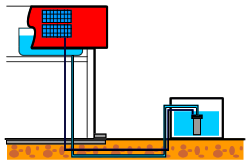 Figure 7 - Water pumping system The water pumping system installed in the Solar House consists of a submerged pump that operates on 12 volt DC voltage and has a flow rate of 500 liters/hour. 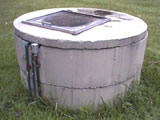 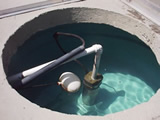 Tank with a submerged 12 Vdc pump 6.1. Photovoltaic system of water pumping simulation 
Comprising two glass tanks positioned with a height difference of 1.25m and a 12 Volts DC pump powered by two 64 Wp PV modules, this system simulates the operation of a photovoltaic water pumping system. The bottom tank is the artesian well, where the DC pump is submerged, and the top one, the water tank, where the energy generated by the photovoltaic modules is stored as gravitational potential energy. You can also simulate the performance of the photovoltaic pumping system at different depths using a throttle valve and a manometer (pressure gauge) inserted at the output of the DC pump. As the valve throttles the section of the pipe, the pressure measured between the valve and the DC pump increases, where the value of the pressure measured in kilograms.force equals height in depth meters.
7. Public Lighting System
Last modified: 02.02.2015
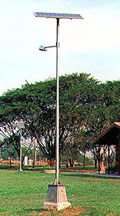
The public lighting systems installed nearby Efficient Solar House are basically composed of a PV module, a battery and a 9 Watts lamp. In general, these systems have a sensor that turns on the lamp automatically.
8. Auditorium
Last modified: 27.01.2015
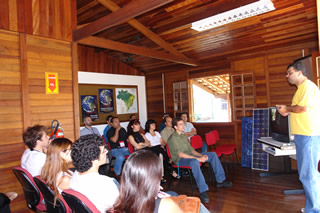
Presentation during visit to the Solar House
Efficient Solar House presents a mini auditorium for thirty people where technical and economical use of renewable solar and wind energy in Brazil aspects are presented.
9. Control Room
Last modified: 27.01.2015
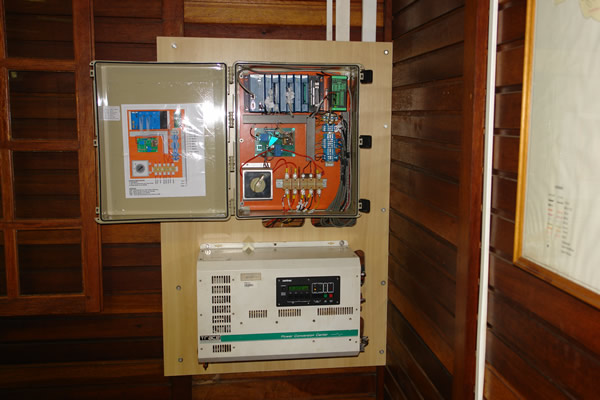
Figure 1 - Layout of the inverter and the data acquisition system in the Control Room.
In the control room there are the voltage inverter and the data acquisition system. 9.1. Voltage Inverter Regardless of the source chosen by the controller (battery, PV panels or wind turbine), the voltage is always continuous (CC).The equipment of the house (as in a normal house) must be powered by alternating current (AC) 120 V at 60 Hz. Conversion of 48 Vdc at 120 Vac is taken by the inverter voltage. 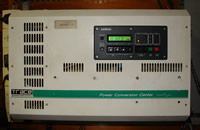
Figure 2 - Voltage Inverter
In the Solar House the supply of electricity in alternating current (AC) was chosen to simulate a conventional house and allow the use of domestic electronic equipment. To condition the power output of the autonomous generation system at 48 Volts DC to meet the load at 120 Volts AC at 60Hz, an electronic converter, known as voltage inverter is used. A single voltage inverter is used to supply the whole house with alternating current (Figure 2). Another option would be to use smaller inverters distributed by appliances or load points. This second option has the advantage of preventing total power outage in the event of an inverter default. In case there is a single larger inverter, the occurrence of a default would leave the house without power until the replacement or repair of the inverter. The distributed system has the disadvantage, however, of the need to use higher amounts of larger diameter wires, as it operates with DC power at a lower voltage (48Vdc against 120 Vac), the current is increased for the same transmitted power. The inverters are capable of providing stable output voltage in terms of amplitude and frequency, with suitable level for use with commercial appliances. The task of discharge control of the batteries is also held by central voltage inverter of CSE. 9.2. Data acquisition system 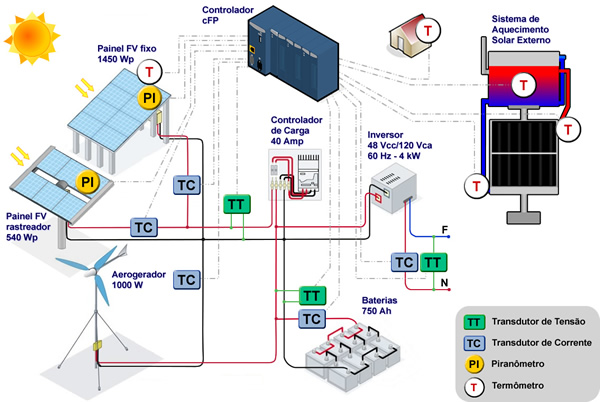
The Data Acquisition System (DAS) of the Solar House conducts the activities of collection, processing and storage of measured data from physical phenomena that characterize the behavior of the power generation system and solar water heating system and describe environmental conditions of the Solar House. The information gathered can be used for different activities such as: (1) supervision and control; (2) performance analysis; and (3) maintenance planning.
This system is designed to monitor all quantities of voltage and current in the main points of the solar house (as illustrated in Figure 1.3), in addition to registering magnitudes of temperature and solar irradiance. The DAS provides two types of output data: - Real-time measurement: shows values of series measured in 1-second intervals during a determined period. The oldest data is discarded;
- History of measured data: contains statistics of intervals of 5 minutes (300 measured values every 1 second).
The Data Analysis and Monitoring System allows you to see the historical measured data and monitor real-time operation of the Efficient Solar House.
10. Energy Efficiency Room
Last modified: 27.01.2015
In the energy efficiency room there can be found the panel of lighting demonstration, the meter panel, the consumption simulation model, the digital meter, the Ampere-hour meter developed by CEPEL, the consumption measurement appliances counter and the fuel cell. 10.1. Lighting demonstration panel 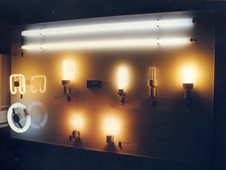
Lighting Panel
This panel is composed of various types of light bulbs and a power meter. When connected to a particular light bulb, the meter shows its consumption in Watts. With this panel you can compare the effect of lighting and the consumption of different light bulbs. A particularly interesting demonstration is the comparison of an incandescent bulb to a compact lamp of the same color temperature. With about 30% of consumption, the compact lamp has the same characteristics of the incandescent light, visually observed by the visitor. 10.2. Consumption simulation model 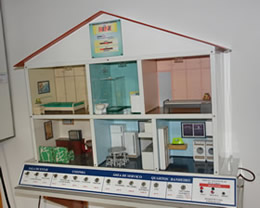
Consumption simulation module
This is a model of a house with several simulated appliances inside. Through switches, you can select which appliances will have a simulated operation. The total consumption of selected appliances is shown in a digital "display". By simulating, the visitor learns which equipment in their house consumes more energy. 10.3. Appliances consumption measurement counter 
Appliances Consumption measurement counter
The appliance consumption measurement counter measures the demand for power (watts) and power consumption (Watt-hour) of electrical equipment and displays the values measured in two digital displays in real time. Through these measurements, the visitor can know the consumption of conventional appliances. 10.4. Fuel cell 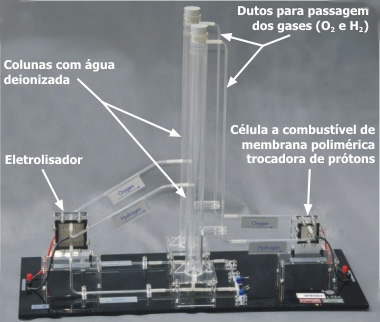
Demonstration with fuel cell and electrolyzer kit
Fuel cells are electrochemical devices that convert the variation of the free energy of an electrochemical reaction directly into electrical and thermal energy, not involving thermodynamic cycles of indirect conversion. In the demonstration kit shown below, the hydrogen (H2) and the Oxygen (O2) are produced in the electrolyzer (by water electrolysis) – whose flow chart is shown in (1) – from deionized water and a source of electrical energy, such as photovoltaic modules shown in (2). The water stored in the columns is consumed in the electrolyzer, producing the gases H2 and O2 that pass through the same column , so as to stabilize the supply and to ensure the humidification of these gases, reaching the proton exchange polymeric membrane fuel cell – as for example, the ones demonstrated in (3) or (5), whose components are shown in (5) and (6) and the flow chart is depicted in (4), where these gases go through a series of electrochemical and diffusional processes – inside the fuel cell, as depicted in (7) and (8) – which result in the production of electrical energy and heat. 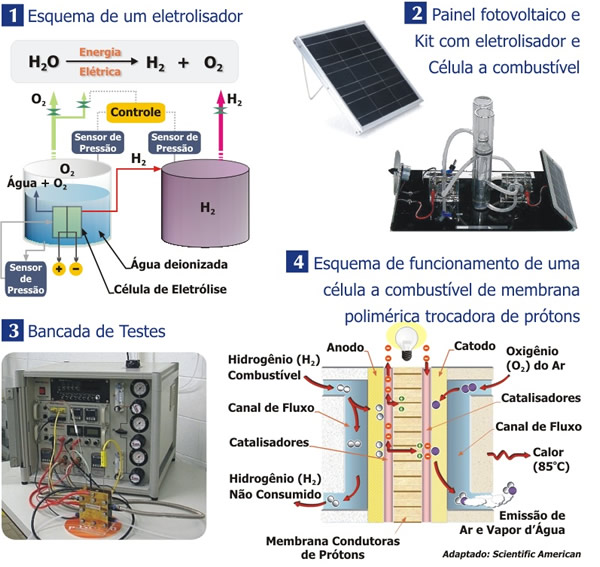
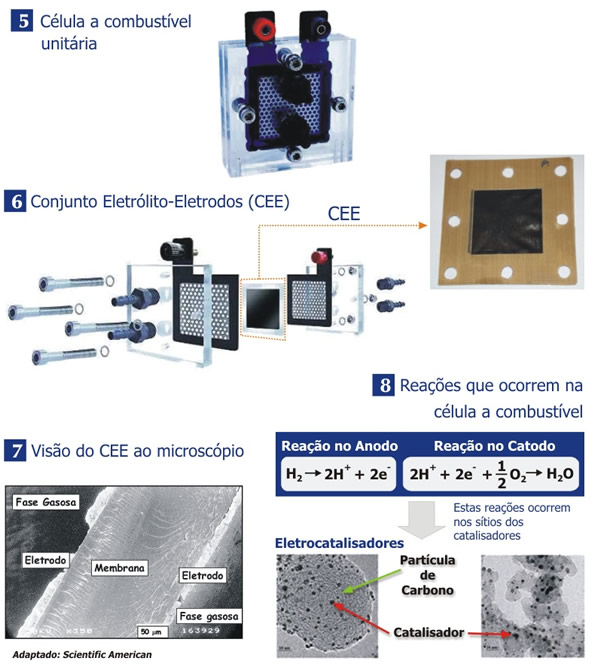
10.5. Meter panel 
Meter panel
The meter panel provides the possibility of viewing the historical evolution of the electricity meters in Brazil since 1906. 10.6. CEPEL digital meter 
This meter, developed at CEPEL, presents the possibility of measuring differentiated tariff rate depending on whether the time of consumption is located at peak or off-peak hours. The switching is remotely operated by the concessionaire. Construction features of the device make it virtually immune to common types of fraud. 10.7. Ampere-hour meter 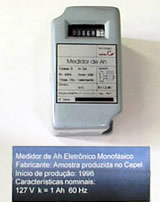
Also developed by CEPEL, this meter is a low cost meter for the use of low consumption consumers. It is not strictly a power meter, as it is sensitive only to the current. However, as the voltage presents low fluctuation, the results are on average very close to those which would be read with an energy meter, with the advantage of having a low cost. The device got a patent in the United States, which opens doors to the international market.
11. Kitchen
Last modified: 27.01.2015
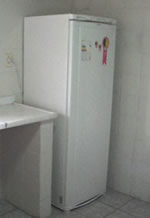
Efficient Refrigerator with PROCEL Label
At the Solar House kitchen there are efficient appliances. Thus, it received PROCEL Label.
PROCEL instituted an annual award for manufacturers of energy efficient equipment. Manufacturers submit their devices to be tested, and the most efficient in each category receives an award for energy efficiency. CEPEL participates in the awards performing tests on various equipments. The efficient refrigerator exposed in the Solar House kitchen was the refrigerator awarded in 1996. It has a power consumption of about 50% less than a non-efficient refrigerator and its price is only about 10% greater than that of an ordinary refrigerator.
12. Bathroom
Last modified: 27.01.2015
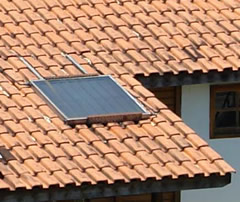
Solar Heating System
The Efficient Solar House does not use electric shower because this is one of the largest energy consumers in a house. Thus, the water used in the bathroom is heated by means of a solar heating system, shown on the image. The water in the bathroom shower and kitchen tap is heated by a plane solar collector. This type of panel, unlike the PV modules (which transform solar energy into electricity), collects the heat from the sun and transfers it directly to the water flowing in the pipes. The heated water is continuously stored in a thermal reservoir. The movement of water occurs by gravity and depends on the height difference between the water tank and the panel and the density difference resulting from the difference in water temperature at the inlet and outlet panel. As due to the characteristics of the roof of the house, the height difference between the water tank and the solar collector is small, the movement of water through the panel largely depends on the density difference caused by the temperature difference. A small pump running for a few minutes starts the process until the temperature differential compensates for the little difference in height and circulation process can continue without the aid of the pump.
|